Art & Exhibitions
How Paris’s Once-in-a-Lifetime Mark Rothko Exhibition Changes the Way We See His Revered Paintings
Christopher Rothko and Arne Glimcher explain what makes the Fondation Louis Vuitton show so important.
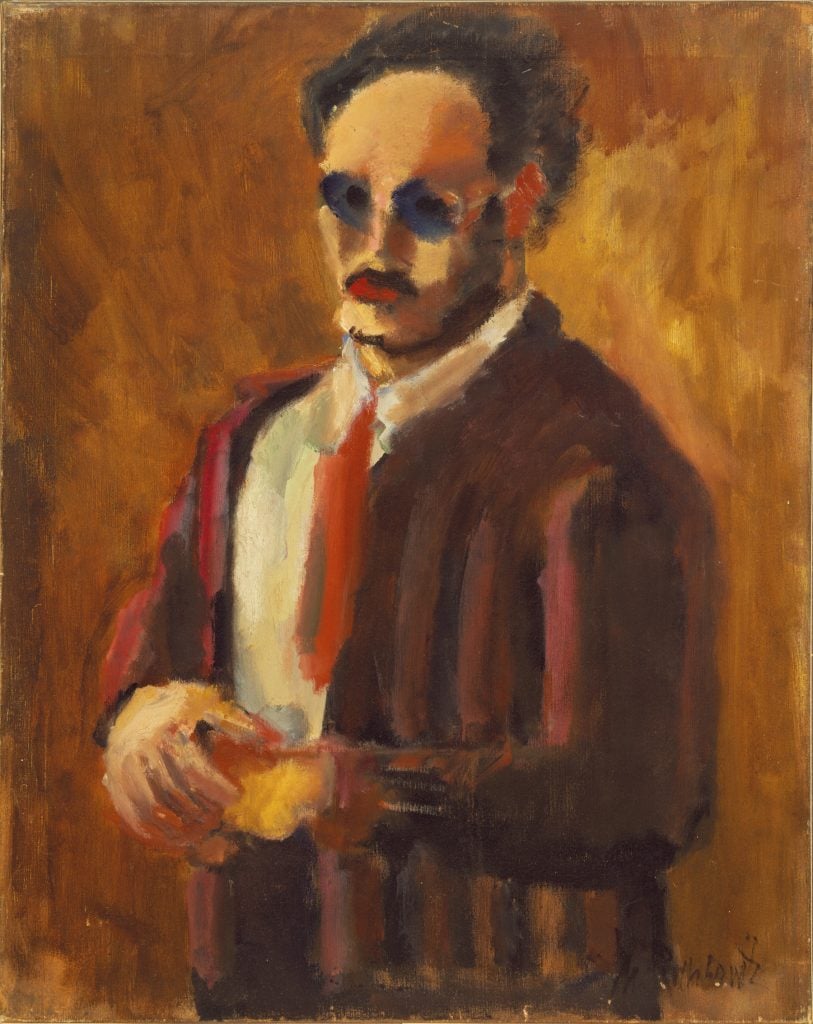
Christopher Rothko and Arne Glimcher explain what makes the Fondation Louis Vuitton show so important.

Naomi Rea

Plenty of people can tell you what a Mark Rothko painting looks like. Posters of the Abstract Expressionist’s seductive fields of color are a fixture on dorm room walls. Fewer people can tell you what it feels like to stand in front of a Rothko painting in person. And until now, I’m not sure anyone could tell you what it felt like to be in the presence of 115 Rothkos all at once—but this transcendent experience is open to a whole lot more people after the Fondation Louis Vuitton opened its stunning encyclopedic winter blockbuster in Paris, “Mark Rothko.”
Most museums would dream of staging a show like this. But these days the massive expenses of shipping, insuring, and loan agreements mean it could only be pulled off by a deep-pocketed private institution. Backed by the billionaire art collector and LVMH chairman Bernard Arnault, the exhibition includes major groups of works lent from the National Gallery of Art in Washington D.C. and the Tate in London, as well as private lenders including the artist’s children Kate Rothko Prizel and Christopher Rothko, the Taiwanese collector Pierre Chen, U.S. collectors Adriana and Robert Mnuchin, Elie and Sarah Hirschfeld, and the Nahmad family.
It’s a huge moment for Paris, as the foundation’s curator Suzanne Pagé, who has co-organized this exhibition with Rothko’s son Christopher, can attest.
“Nobody in four generations has had the possibility to see Rothko in Paris,” Pagé told me. While there are two Rothkos in the Pompidou’s collection, the last time the artist had a retrospective in France was 1999—a show Pagé herself curated at the the Musée d’Art Moderne. “A lot of young people have posters, but it is a great betrayal to enter into the emotional painting of Rothko that way. What is essential in the painting of Rothko are the vibrations, which are totally reduced in a poster,” Pagé explained. “You have to stop, look, and be captive with your body, with your soul, with everything in you, and you are hypnotized.”
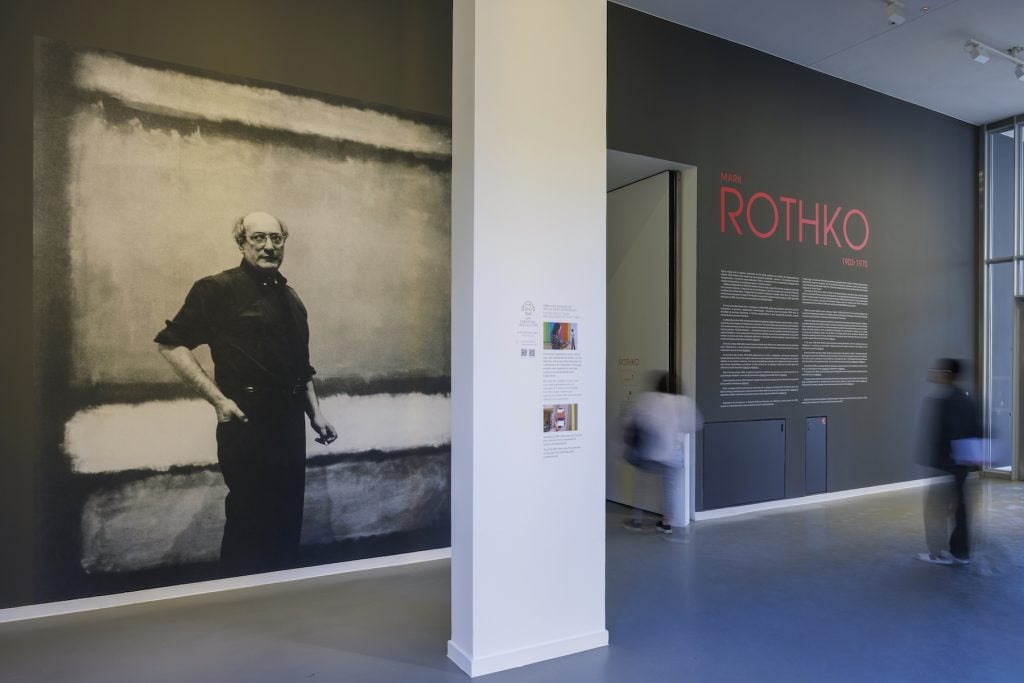
“Mark Rothko” at the Louis Vuitton Foundation in Paris on October 17, 2023 in Paris, France. (Photo by Luc Castel/GettyImages)
The exhibition offers plenty of discoveries, from Rothko’s early figurative work to a re-evaluation of his later, darker paintings. It does a fair amount of work to undo how the macabre facts of Rothko’s biography—including his death by suicide aged 66—have colored the interpretation of these late works. A popular myth, which the curators deem reductive, has it that Rothko’s late-career turn from his classic, brightly-colored paintings towards a darker palette of rusty reds, purples, and blackish hues reflected his declining mental state.
“A retrospective by definition needs to tell the whole career. And of course it needs to tell the whole life,” Christopher Rothko told me as we stood in front of some of these murky late works. “I think for me the most important thing is for people to experience the career, see the trajectory of the painting, and not start with the idea of suicide and then view the career backwards—because that’s a distortion. Nobody lives their lives backwards.”
The show takes a basically chronological approach, beginning in a dimly lit subterranean gallery with Rothko’s early works. Painted in New York in the 1930s, where Rothko settled as an adult after emigrating to the U.S. from Russia as a child, these lonely and claustrophobic figurative paintings convey the spirit of the Depression era. His muted “subway paintings” concentrate on oppressive architectural features, corridors, staircases, and rails. A pair of unsettling, brassy nudes with faraway eyes might surprise those unfamiliar with this early period, as might the artist’s lone self-portrait, a dense painting from 1936, where Rothko cuts an inscrutable figure, his gaze obscured behind dark glasses.
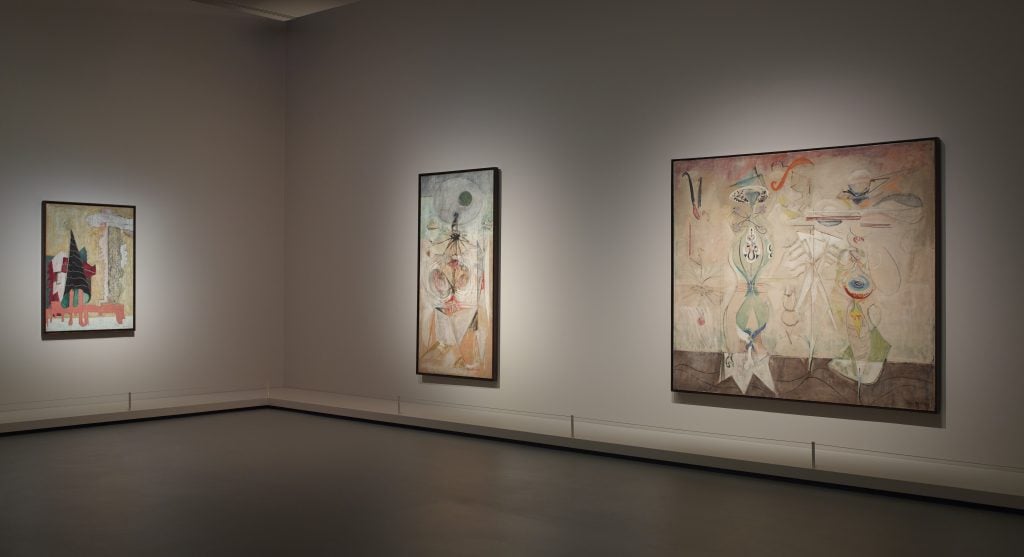
Left to right : Mark Rothko, Sacrifice of Iphigenia (1942), Tiresias (1944), Slow Swirl at the Edge of the Sea (1944). Installation view, gallery 1, level -1, on view through 2 April 2024 at Fondation Louis Vuitton, Paris. ©1998 Kate Rothko Prizel & Christopher Rothko – Adagp, Paris, 2023.
From the beginning of the 1940s, there’s a marked shift in style as Rothko grapples with expressing the barbarism of World War II through his brush, as well as his own childhood memories of religious persecution as a Russian Jew. A set of aesthetically troubling paintings veer from realism and draw instead on both mythology and Surrealist techniques for accessing the unconscious mind.
This “neo-Surrealist” period where Rothko repeatedly splits, twists, dissects, and reconstructs the human figure comes to a peak in 1946, when we finally get to Rothko’s abstract turn. The next room hits visitors like a blast of wind, intensified by a Mozart opera reverberating through the galleries. In these scrubbed-out, pared-back canvases, we first begin to see the fields of color, amoeba-like, spring forth inside the painter’s mind as he realizes the impossibility of expressing what he sought to through the human figure. These “multi-form” paintings attempt to capture something of inner human realities, grasping into the abyss and tapping into that realm of experience beyond the measurable, the kind of experience that the Romantic poets called “the sublime.”
A quote on the wall situates you with what was going on in Rothko’s mind: “A painting is not a picture of an experience. It is an Experience,” he wrote.
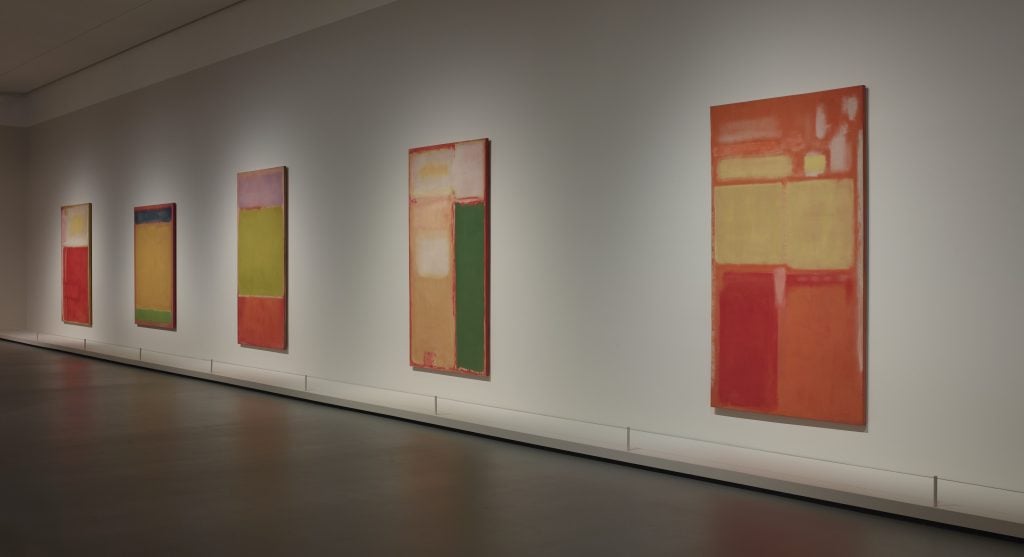
Left to right : Mark Rothko, No. 8 (1949), Untitled (Blue, Yellow, Green on Red) (1954), No. 7 (1951), No. 11 / No. 20 (1949), No. 21 (Untitled) (1949). Installation view, gallery 2, level -1, on view through 2 April 2024 at Fondation Louis Vuitton, Paris. ©1998 Kate Rothko Prizel & Christopher Rothko – Adagp, Paris, 2023.
After that point, the galleries shift gears into the “classic” Rothkos, his best-known rectangular Abstract Expressionist fields of color from the late 1940 and onwards. The largest portion of the exhibition, it includes 70 works, awash with chromatic harmonies of saturated yellows and reds, but also pinks, purples, and blues. Their bright colors have often led observers to misconstrue these ethereal and beautiful works as serene or cheerful. Coming upon them here, having passed through the context of his earlier work, makes palpable how they are just as perforated with existential angst.
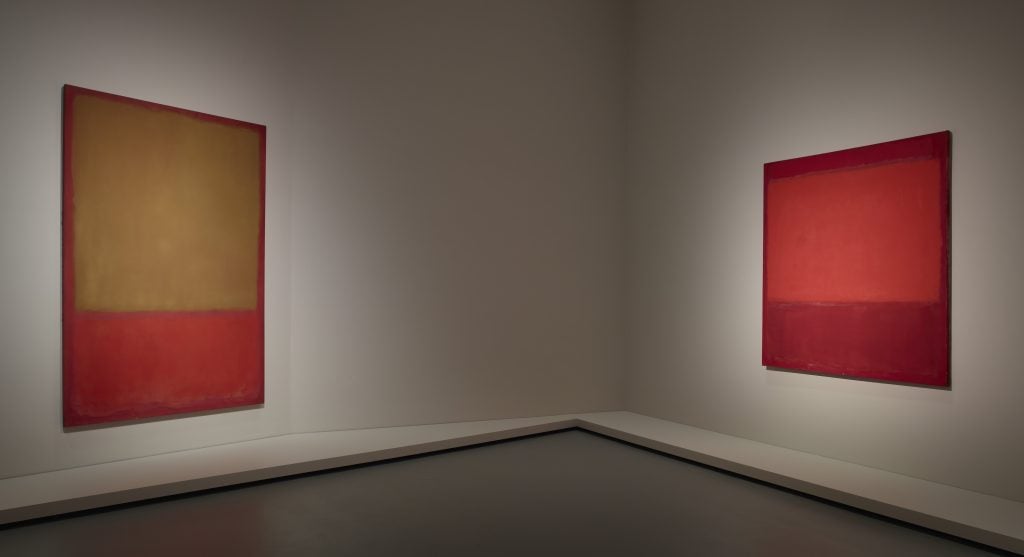
Left to right: Mark Rothko, Ochre and Red on Red (1954), Orange and Red on Red (1957) Installation view, Mark Rothko, gallery 7, level 1, the “Rothko Room” from the Phillips Collection, on view through 2 April 2024 at Fondation Louis Vuitton, Paris. © 1998 Kate Rothko Prizel & Christopher Rothko – Adagp, Paris, 2023.
Through that lens, Rothko’s shift toward his darker hued palette from around 1957 does not feel so much like a break as a natural evolution. Among the examples in the exhibition is Tate Modern’s entire Rothko Room—nine deep red paintings donated by the artist in 1959, originally destined for a restaurant at the Seagram building in New York. Working on a public installation prompted Rothko to change his interaction with the viewer. “He’s no longer trying to grab your attention as you walk by in a museum,” Christopher Rothko said. “He knows that you will be with him for an hour or two, or more, so instead of trying to overwhelm you in a moment with color and emotion, he reduces the tone. He reduces the speed of interaction and lets the painting seep into you.”
After the end of the Seagram commission, Rothko retained this strategy, going even darker for the “black form” paintings, a number of which grace the Rothko Chapel in Houston, Texas. A number of these sonorous works, which at a glance appear monochromatic but hum with just as many colors as the bright paintings, stole the show for me. Rothko was particular about the way he wanted these works to be experienced: not hung like a monument or trophy on the wall, but mounted low, so that you can look at them directly. In the low-lit setting of the gallery, as your eyes adjust to the lighting conditions, the miraculous paintings almost seemed to hover off the walls.
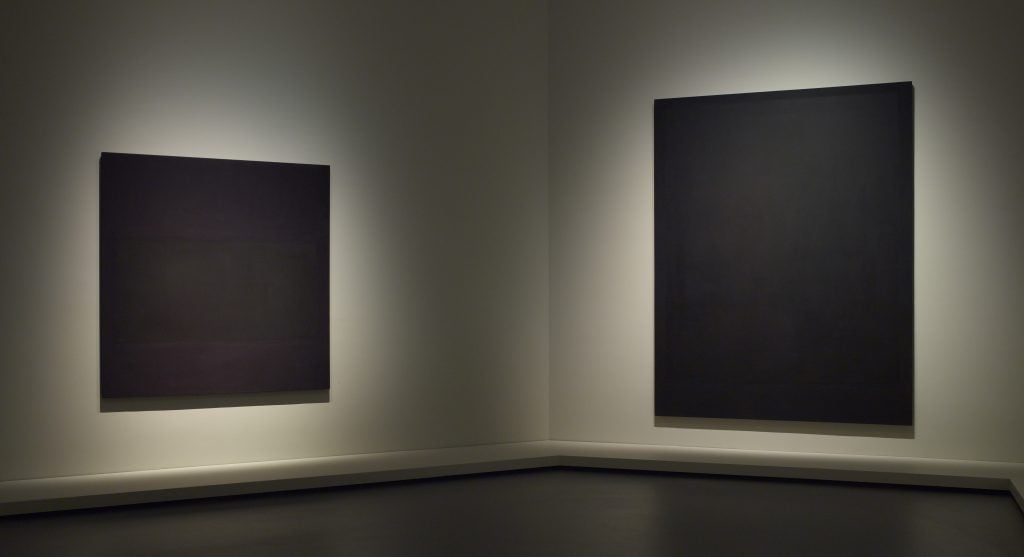
Left to right: Mark Rothko Untitled (1964). No. 8 (1964) Installation view, Mark Rothko, gallery 6, level 1, on view through 2 April 2024 at Fondation Louis Vuitton, Paris. © 1998 Kate Rothko Prizel & Christopher Rothko – Adagp, Paris, 2023.
Pace Gallery founder Arne Glimcher knew Rothko while he was alive—the gallery has represented the estate since 1977—and has always been fond of these later, under-appreciated works, devoting a gallery show to them in 2017.
Speaking over the phone, Glimcher recalled Rothko telling him a story about a “magnificent” dark painting, now in the dealer’s possession. It had been rejected by a collector who had been invited to the studio, but said she would prefer a “happy” painting in the palette for which the painter was most famous. Rothko recounted his reply: “Red, yellow, orange—aren’t those the colors of an inferno?”
Glimcher credited an introduction by Louise Nevelson—who bonded with Rothko, Barnett Newman, and Adolph Gottleib over their shared refugee experience—for entree into a friendship with the notoriously reclusive painter. His 69th Street studio also just happened to be directly across from Glimcher’s apartment.
“Mark let me come to his studio quite often,” Glimcher recalled. “Sometimes, in the winter, it got dark and I’d be coming home from work because I lived across the street, and there would be a light on. I would knock on the door and he would let me come in and sit and talk and show me the paintings that he had been working on.”
Because of those encounters, the dealer has rare insight into the artist’s feelings about some of the later works, including smaller canvasses and works on paper which he made after a heart attack in 1968 meant he needed to work on a less physically strenuous scale. “He liked the feeling of the brush on the paper, how it slid more easily against the paper than against the canvas,” Glimcher said.
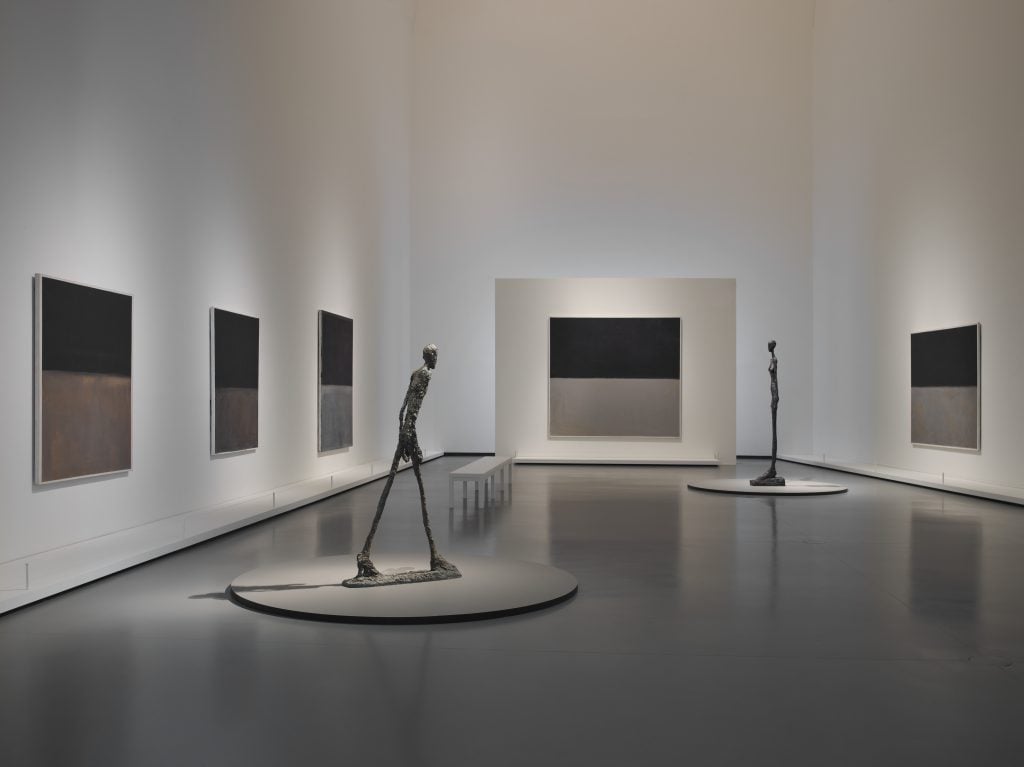
Left to right: Mark Rothko, Untitled (1969-1970), Untitled (1969), Untitled (1969), Untitled (1969), Untitled (1969). Sculptures : Alberto Giacometti, L’Homme qui marche I (1960), Grande Femme III (1960). Installation view, Mark Rothko, gallery 10, level 2, on view through 2 April 2024 at Fondation Louis Vuitton, Paris. ©1998 Kate Rothko Prizel & Christopher Rothko – Adagp, Paris, 2023.
As skeptical as I probably should be about a dealer trying to make a market for less in demand works, I am still persuaded by these sepulchral beauties. The exhibition’s final gallery offers up a number of Rothko’s late black and gray paintings alongside sculptures by Giacometti, as Rothko had originally intended for them to be shown in a never realized commission for UNESCO. The curators position these works, so simple but filled with incredibly rich and beautiful brushwork, as a springboard towards Minimalism. You can certainly see how an artist like Brice Marden might have looked at such works and taken inspiration.
Viewed this way, Rothko’s darker works are rightfully seen as a progression: the artist uses reduced means, and a different chromatic scale, but is still after the same fundamental truths as the earlier works. Through this lens, they could be read as allegorical, with their deepening colors representing Rothko ongoing quest to convey pure human emotion, rather than simply expressing his own feelings. Yet lurking behind the great seduction of the colors in the “classic” Rothko paintings is the same drama: That of the human condition.
“Rothko was always interested in Greek tragedy, and he felt that was what he was attaining and searching for in his paintings: The edge of perception, and taking us forward to someplace else,” Glimcher told me.
With everything going on in the world right now, viewers might find catharsis in these paintings. I certainly did.
“Mark Rothko” is on view at Fondation Louis Vuitton in Paris through April 2, 2024.